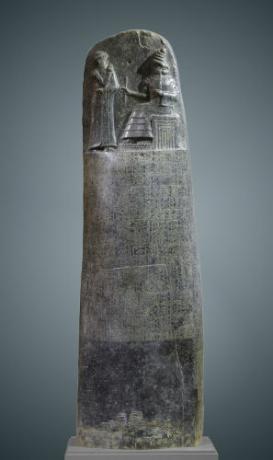O CodeinHammurabi was a code of laws created at the behest of Hammurabi, king of Babylon in the 18th century BC. Ç. This code of laws dealt with how to proceed in certain stipulated cases that could lead to disagreements between people. Thus, issues about work, marriages and crimes were resolved through this code, which had the Law of Talion as its principle.
Accessalso: What do you know about the Assyrians, people who inhabited northern Mesopotamia?
Understanding the Code of Hammurabi
The Code of Hammurabi is a kind of set of laws created in Mesopotamia around the 18th century a. Ç. and it is considered a summary of legal traditions that have existed in that region for generations. Basically, the Code of Hammurabi stipulated shapesinpunishment for certain behaviors of Mesopotamian citizens.

The code is so named because it was organized during the reign of Hammurabi, the sixth ruler of the first dynasty of Babylon and the former of the
Babylon's first empire. It was during the reign of Hammurabi that the Sumeria and Akkad were unified under the rule of the city of Babylon.Hammurabi is believed to have ruled Babylon from 1792 BC. Ç. to 1750 BC Ç. As stated in the Code of Hammurabi, the objective of the Babylonian king in organizing these laws was to ensure what was fairest for those who had a dispute with someone. In the code, the Babylonian king defined himself as king of justice.
The Code of Hammurabi was not the first code of law in Mesopotamia, since in the 21st century a. C., the Ur-Namu Code. This code brought capital punishment (death penalties) for some crimes, and for other actions, there were penalties such as imprisonment and payment of fines.
According to historian Paul Kriwaczek, the Code of Hammurabi was a great advance from a civilizational point of view to Mesopotamia because it mediated disputes through this collectively accepted system. This mediation was important for the stability of Babylonian society because it prevented misunderstandings from becoming conflicts that shook the order of the Babylonian empire.|1|.
The Code of Hammurabi was written in the Akkadian language in the form of the cuneiform script developed by the Sumerians. It is currently the oldest Babylonian inscription found.
Accessalso: What was the Standard of Ur?
Principles of the Code of Hammurabi

The Code of Hammurabi was based on Lawintalion, which brought the idea of a proportional retaliation for the crime committed and had as its motto the phrase: "an eye for an eye a tooth for a tooth”. This code had 282 laws which brought "sentences referring to the family, slavery and professional, commercial, agricultural and administrative law"|2|.
Historians discovered the existence of the Code of Hammurabi in the early 20th century, when a stele containing the articles of that code was found in the territory of present-day Iran. This stele was next to the ruins of Susa, an ancient city in the State of Elam, a neighboring kingdom that attacked Babylon in the 13th century BC. a., taking the stele like spoils of war.
The Code of Hammurabi stipulated social classes in Babylon, three in all:
- free man, called awilum;
- Fidalgo (lower class), called mushkenum;
- slave, called wardum.
This division of social classes is important to mention because the punishments of the Code of Hammurabi had different levels of rigor for each social class. Among the determinations inscribed in the code are:
Example 1: terminationinawedding
137th – If a man wants to separate from a woman who bore him children, or from the wife who bore him children, he must give this woman back her dowry and give her part of the income from the field, the garden and her goods, so that she can raise the sons. If she raised her children, she should be given a share of all that is given to the children, equal to a child's share. She can marry the man of her heart|3|.
Example 2: aboutOwork
228th – If an architect builds for someone and doesn't do it solidly and the house he built falls and injures the owner to death, that architect must be killed.
229th – If the owner's son is killed, the architect's son must be killed.
Grades:
|1| KRIWACZEK, Paul. Babylon: Mesopotamia and the birth of civilization. Rio de Janeiro: Zahar, 2018. P. 229-230.
|2| Idem, p. 228.
|3| Idem, p. 229.
Image credits
[1] ileana_bt and Shutterstock

